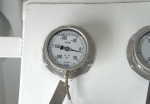Step 3 of 4•10 minutes read
Precautions to be Taken During Operations
When preparing to receive nitrogen from a terminal ashore, the ship and shore should agree in writing on the procedure to be followed and additionally on the following:
- Gas supply.
- The volume of Nitrogen required.
- The flow rate in standard cubic meters per minute (m3/min).
- The maximum for each case.
Special care must be taken when nitrogen is supplied to the ship directly from evaporating liquid nitrogen. This is usually done when the Nitrogen is being delivered by a road tanker fitted with a vaporizer. In such cases, the volume and flow rate can be extremely difficult to control, and therefore, the agreed delivery figures might be exceeded.
Nitrogen should never be delivered to a ship in that way, and if a ship suspects that traces of liquid nitrogen are arriving at the manifold valve, which is usually indicated by the ice formation on the ship's lines and valves, or that the agreed procedure is not being followed, the operation should immediately be stopped until the problem is solved.

Pressures of gas should be carefully monitored at all times. Photo courtesy of Prospero.
Prior to any shore nitrogen being received onboard, it is important to ensure that the entire procedure required is properly discussed with the shore representative and the details of this discussion are recorded. Additionally, precautions should be put into place to ensure the operation is carried out in the safest way possible.
In order to avoid access pressure, a small diameter pipe at the manifold is used to control the flow of the nitrogen from ashore. This precaution ensures that the increase in pressure can be safely handled by the Pressure Vacuum Valve.
Crew members should be stationed at the loading manifold valve during the operation in order to ensure that the valves on the loading line are operated in the agreed sequence. In doing so, the ship will have full control of the flow of nitrogen.
Where remotely operated valves can be easily and more efficiently closed by a crew member situated in the cargo control room, who is also monitoring tank pressures, it is still advisable to station crew members at the loading manifold since this is deemed to be the best position to react without delay to any indication of issues. A pressure gauge is fitted to continuously monitor the pressure inside the tank.
In order to avoid over-pressurization, it is important to ensure that the open vent of a cargo tank which is to be dried or inerted, has a greater flow capacity than the inlet. Usually, this is achieved by leaving the tank hatch open.
When local conditions demand close venting of the tank due to vapour control requirements, the nitrogen pressure and flow rate should not exceed the capacity of the venting system. During the entire operation, the tank pressure should be monitored.
As with all inert gases, when using Nitrogen onboard, there is a potential health hazard, and therefore, it is absolutely necessary to ensure that all the crew members are not exposed to vapours vented from a tank while it is being purged or inerted. With that said, areas on the deck that might be of hazard must be properly cordoned off and a placard stating the hazards shown.

Restricted Area sign cordoning off a hazardous area onboard. Photo: Jörgen Språng
When tanks are required to be padded on completion of loading, the preferred way to do so would be to purge the tank prior to loading and then vent the nitrogen during the loading, leaving the tank with a positive pressure of nitrogen at the end of the operation. This is preferred as it prevents incidents of splashing or cases of gas traps to cause spillages on the deck.
However, sometimes tanks need to be padded after the completion of the loading operation. In such cases, the nitrogen is bubbled through the cargo to the vapour space on top. With that said, the following precautions should be observed during such operations:
- The venting should take place through the oil tank hatch provided there are no restrictions due to local requirements or due to the nature of the cargo.
- The oil tank hatch should be left open by about an inch to permit easy venting.
- It is important to continue venting until the required oxygen content in the tank is reached.
- The flow of nitrogen inside the tank should be controlled gradually and any abrupt changes in the flow should be avoided since these will cause a large volume of air bubbles to form, possibly causing splashing of the cargo from the tank hatch.
- It is extremely important for the person checking the oxygen content inside the tank, to stand at an angle of 90 degrees to the lee side of the wind direction. They should carry a portable oxygen meter to monitor the tank atmosphere and add a personal gas detector to monitor the atmosphere around them for any toxic gases or depletion of oxygen.
- If venting taking place at deck level is not permitted due to local requirements, the flow rate must be at a maximum of 80% of the Pressure Vacuum Valve setting. In this case, the oxygen content would be monitored from a sample cock in the vent line.
It is important to note, that these precautions are for chemical tankers which are loading into a clean and gas-free tank and not for oil tankers where tanks may contain flammable and toxic gases and therefore will require additional precautions.